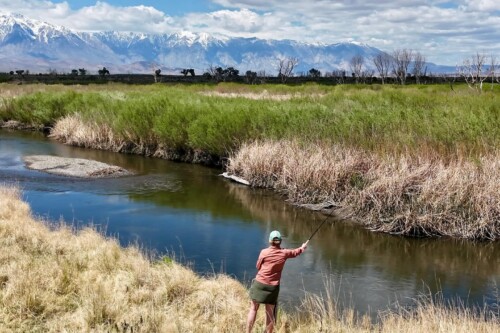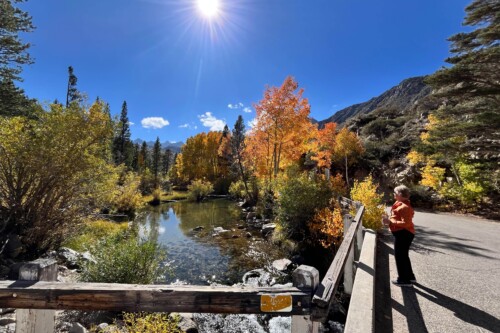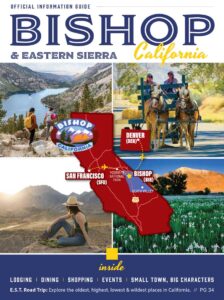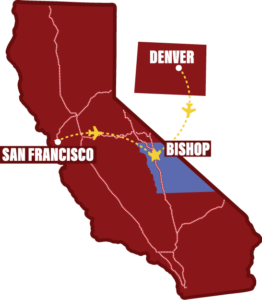Take a lazy afternoon drive through Round Valley and stop by the Millpond Recreation Area. You’ll experience a magical mix of autumn colors and the charm of a quiet rural community. Look for stands of towering cottonwoods in scenic spots. This time of year, bright yellow rabbitbrush is in full bloom, beautifully complementing the trees. You’ll also see bulrushes along the creeks, the occasional apple tree, a few farm animals, and old structures with weathered, picturesque patina. All of it sits beneath the towering Sierra Nevada, creating a backdrop that feels straight out of an epic film.
Categories
Behind the Lens: A Guide to California Foliage Spotting
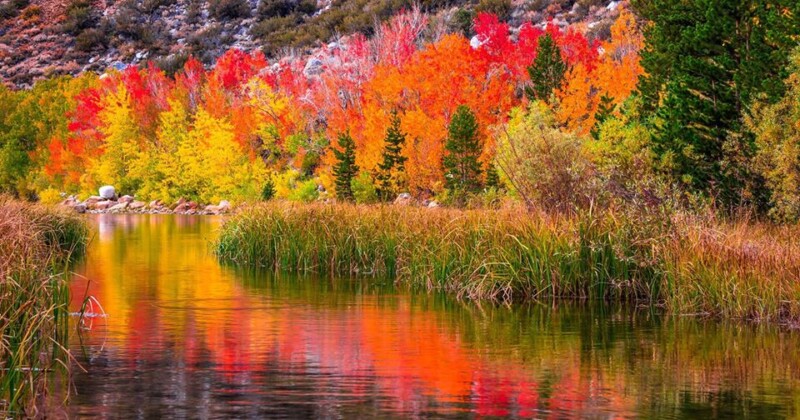
NorFall lasts a long time in the Eastern Sierra, making it one of the best places in California for capturing fall foliage. The region’s unique topography creates a gradual transition into winter—starting at the highest elevations and slowly moving down to the open plains of the Owens Valley. Cooling begins in September, with temperatures dropping significantly in the mountains, even as summer lingers in the valley below.
A Slow Progression
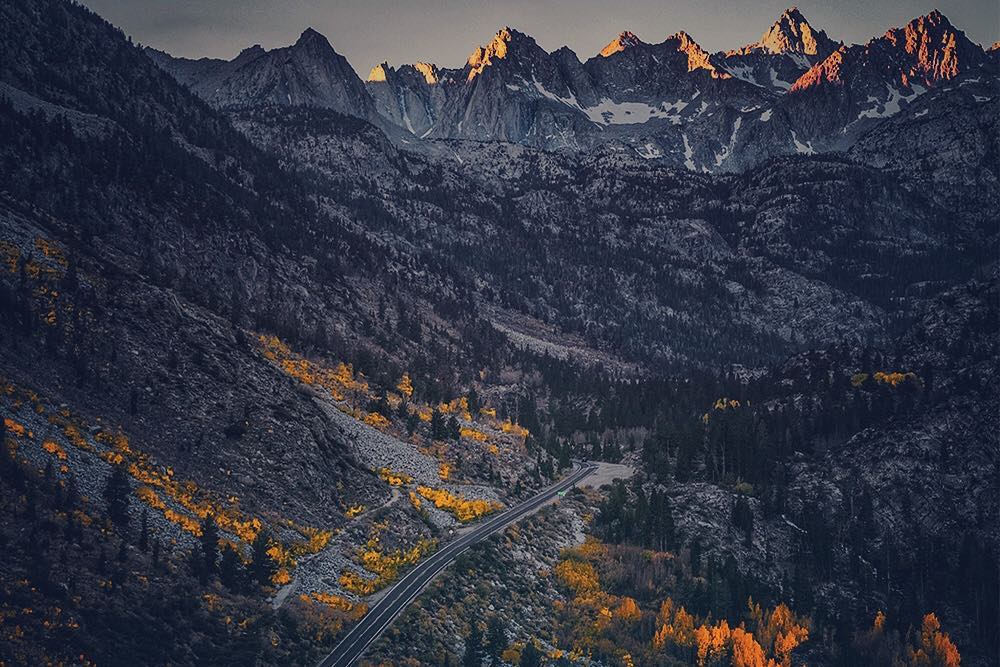
The color change begins high too. Over the course of many weeks, often well into November, the color tumbles down the mountain and out across the plain like spilled buckets of paint.
Drops of yellow splatter the stands of aspen that grow near the tree line, around 12,000ft ASL (above sea level). Soon it spills into the groves and luminous yellow swaths appear with dribbles of bright orange and deep crimson. A blush spreads across the mountainside spreading a golden trim along the shores of sparkling blue mountain lakes, alongside streams, and tracing contours down the canyons. The dark green of evergreen trees mixes with the bright colors and the silvery grey granite crags rise above the surge of color.
Often large clouds gather and billow over the mountain peaks during the day. Then as evening approaches strong winds aloft lift, smooth and shape them into lenticular wave clouds and the setting sun creates a fiery display that rivals the show on the ground.
This spectacle in the sky is brief and unpredictable, but the colors on the landscape follow an established pattern in time and place that is almost as predictable as the nightfall after the sunset.
Where and When
Like all things in nature, fall colors are at the mercy of Mother Nature. The timing depends on when temperatures drop in the high country, which triggers the leaves to change. For the best tips on when and where to go, check out our Fall Color Guide—it’s your go-to resource for all things autumn in the Eastern Sierra.
That said, here’s a general overview of how the California foliage show typically unfolds in this region.
Bishop Creek Canyon – early September to early October
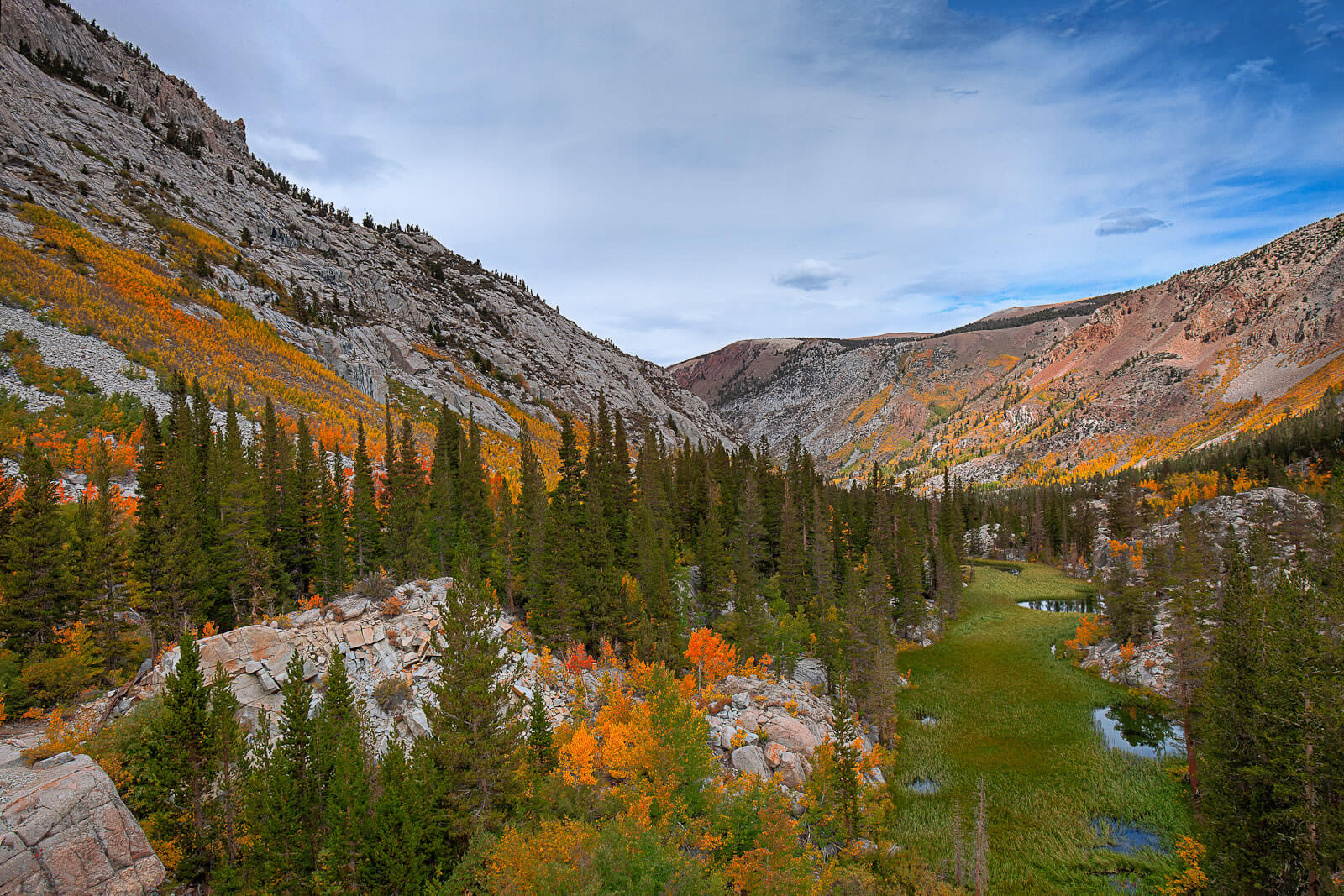
Bishop Creek Canyon is one of the most spectacular places for California foliage in the fall – if not the country. It is a large area of about 30 square miles where the North, Middle, and South Forks of Bishop Creek drain down toward the Owens Valley. At the head of each fork is a large lake, North Lake, Lake Sabrina at middle, and South Lake. Numerous other smaller lakes lie along the creeks.
A short journey of no more than 20 miles west of Bishop on US Highway 168 will take you well into the rugged high country. This is the place to start your fall color spotting. From a few days to a week or more before the autumnal equinox, which occurs every year on September 22nd or 23rd and occasionally on either the 21st or 24th, the color change can begin.
Witness the spread of color that begins high above the lakes in the upper reaches of the canyon. The views at each lake basin are mesmerizing for the sheer magnitude of the surrounding crags and the swaths of brilliant color that appear to flow out of the rock toward the deep blue water like lava.
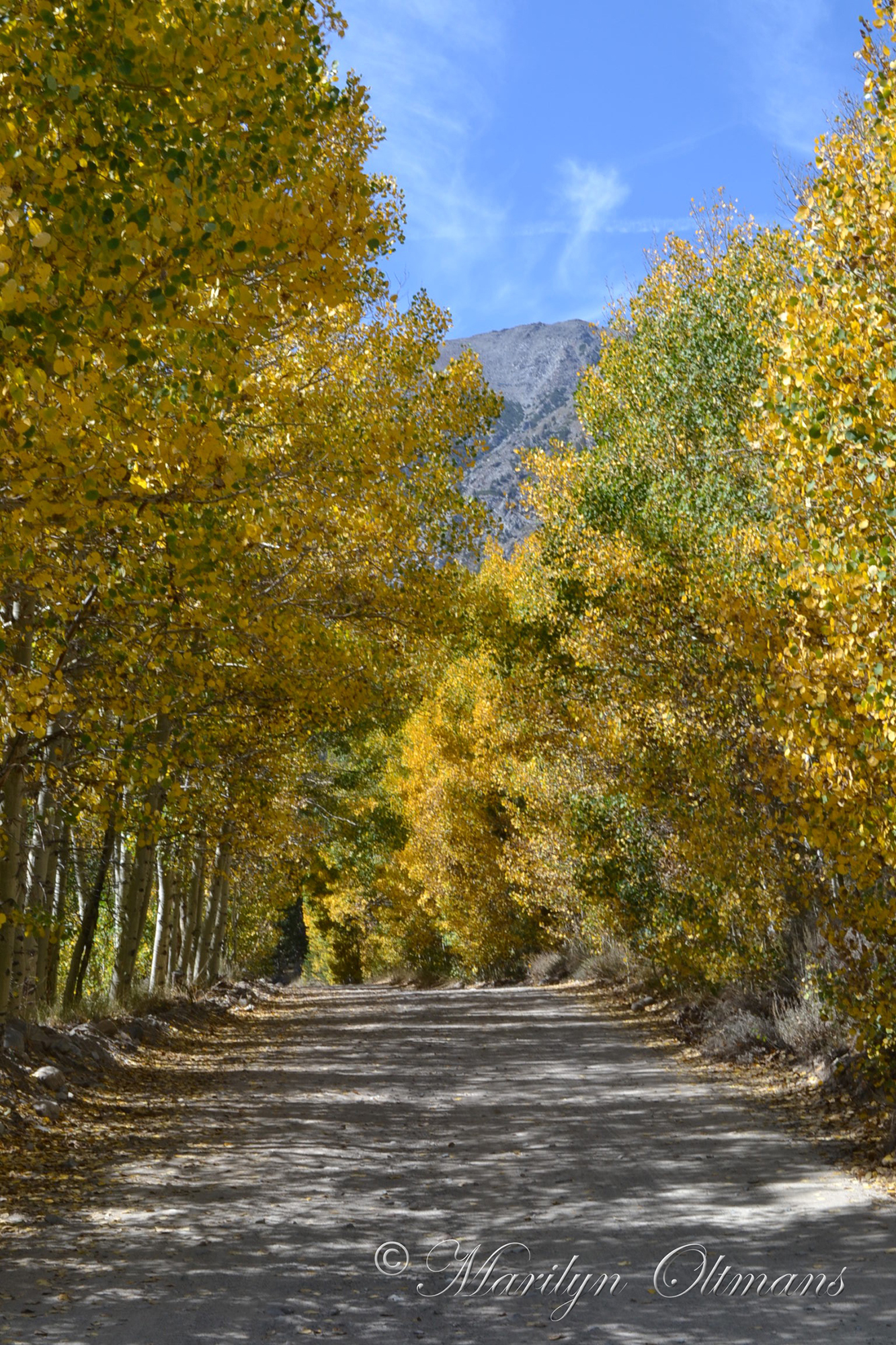
Visit each of the lakes in early to mid-September and as the days shorten spend time in the groves that line the roads to these lakes and on the paths into the adjacent wilderness. Exploration on foot from any of the turnouts and trailheads will take you deep into the explosion of color.
North Lake’s Golden Confetti
A late afternoon drive to North Lake is sublime. Turning off from Highway 168 the road crosses a narrow bridge then dips through a grove of willow and aspen that shake and shimmer like suspended gold confetti. Continuing steeply up the mountainside it rounds a bend and levels out along a gravelly traverse with an impressive view down into the canyon below that is not for the faint of heart.
Then with one more short sweeping turn you’ll find yourself enclosed under a shining arbor of fall colored aspens. It feels quite ceremonious to drive through this glowing tree tunnel and emerge from this short passage with your heart lightened and spirit uplifted.
Toward the end of September and into early October the spill of yellow, orange and crimson descends further down the canyon. The large groves of aspen surrounding Cardinal Village Resort and the tiny settlement of Aspendell seem to herald the holiday season. Every view and image is picture postcard perfect.
Lower Rock Creek Canyon – mid September to mid October
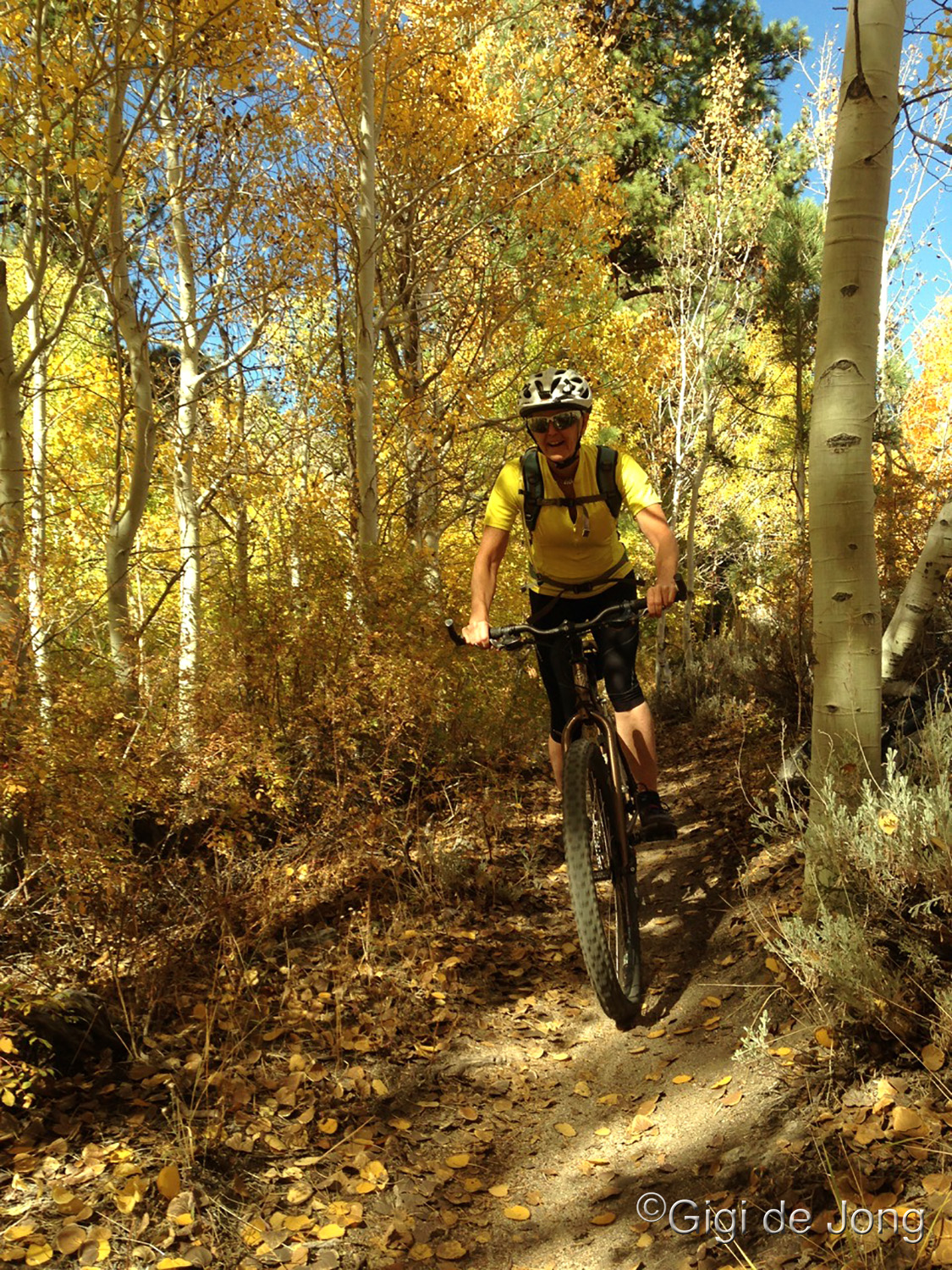
Fall color spills abundantly down all the canyons of the Eastern Sierra. Lower Rock Creek canyon north of Bishop is the place to go for a more adventurous view of the changing of the season. This is the gold standard for mountain biking in the Eastern Sierra. It earns gold for its superior ride and also because fall is the golden season in this beautiful narrow canyon.
Just 25 minutes north of Bishop, this incredible trail offers a bit of everything. You’ll find fast, sweeping turns, rocky and root-filled sections, and overhanging tree canopies. The trail also features steep canyon walls, a talus field, and a rushing stream with low wooden bridge crossings. You can start a bike ride at the junction of Old Sherwin Grade and Highway 395 near Tom’s Place, or enjoy a gentle hike from the lower trailhead at Paradise. Whether you’re up for the mountain biking challenge or prefer a relaxed walk, Lower Rock Creek is sure to leave you breathless with its beauty.
Round Valley and town of Bishop – early to late October
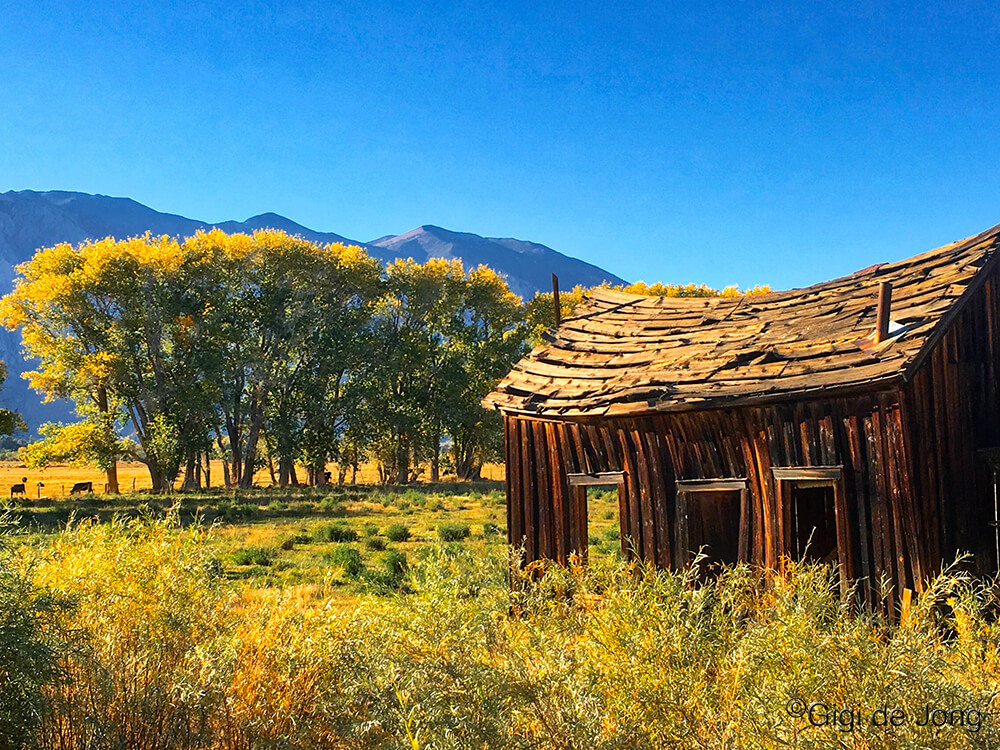
Lower down, where the canyon opens up to the broad valley below, the trees are sparse, but the color creeps relentlessly through the ubiquitous high desert scrub. It seeps into the large cottonwood trees that dot the emerald green grounds of the Bishop Country Club and line the creeks of the valley floor.
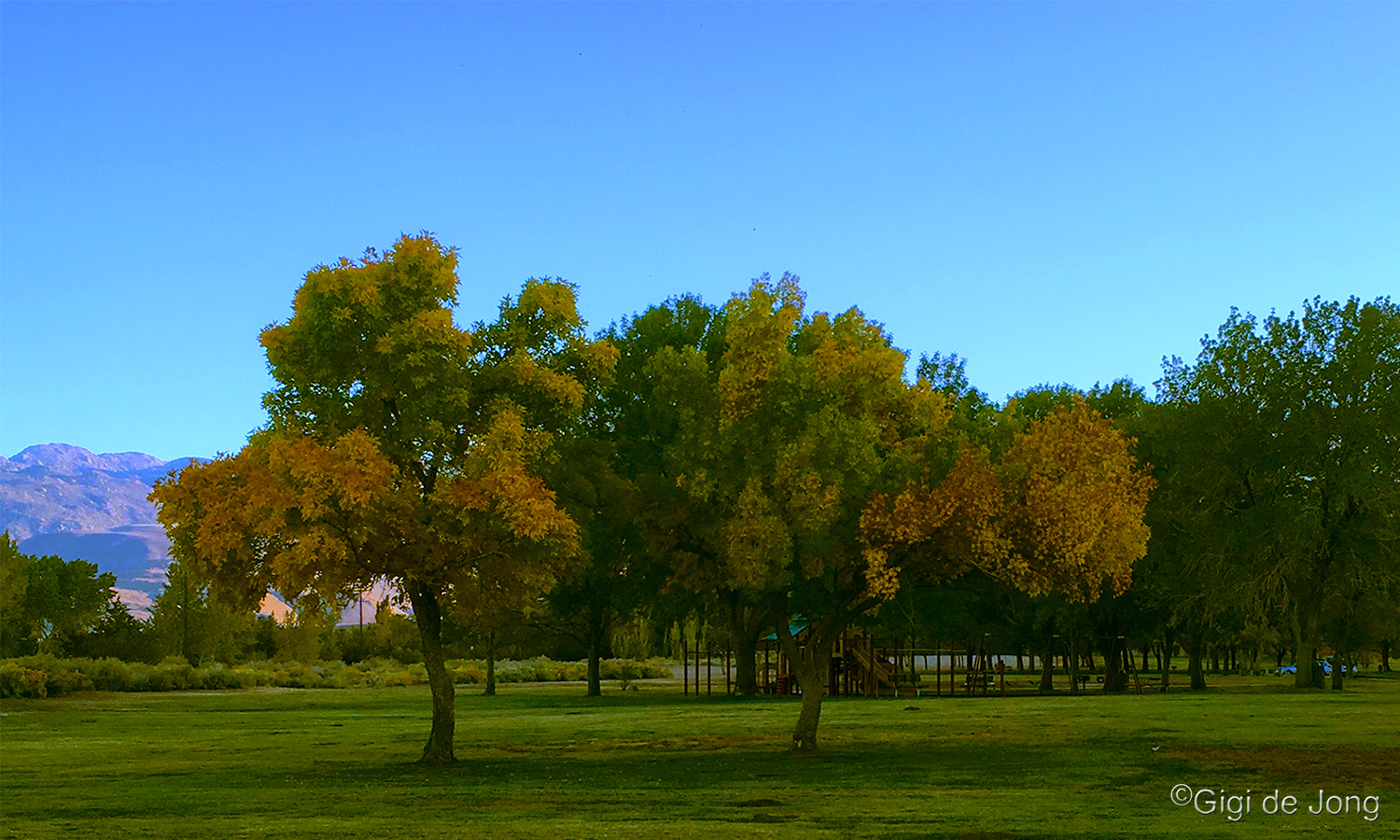
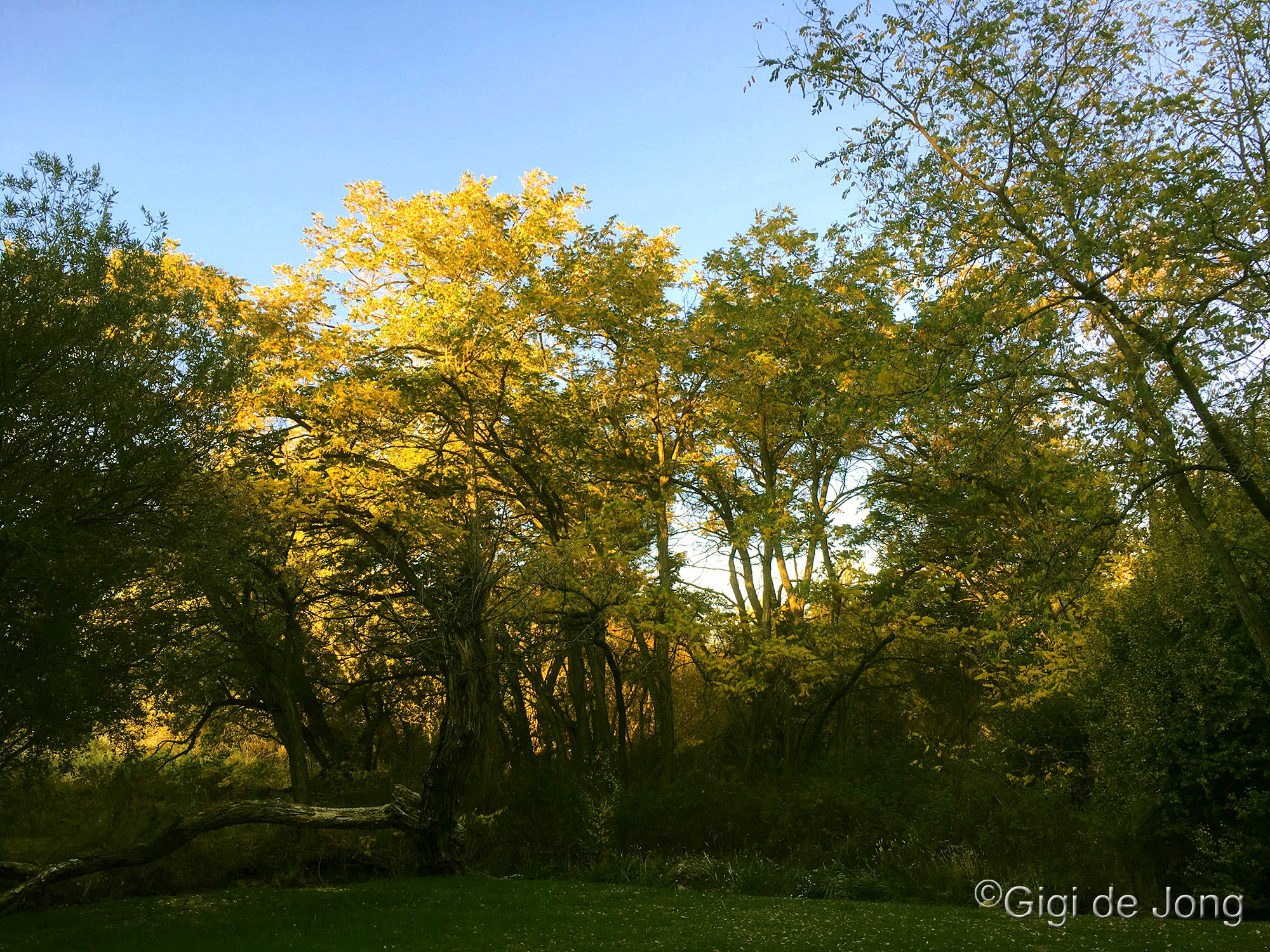
Large individual trees in yards and fields in and around the town of Bishop become an iridescent yellow. Trees full of color poke out from above rooftops and gather in front yards, like neighbors catching up on the latest gossip.
Take a slow drive, easy bike ride, or relaxed walk along West Line Street—the road leading up to Bishop Creek Canyon—for a beautiful display of fall colors. Izaak Walton Park is charming at any time of day. The small forest on the corner of Reata Road glows beautifully in the early morning and late afternoon light.
Owens River – late October to early November
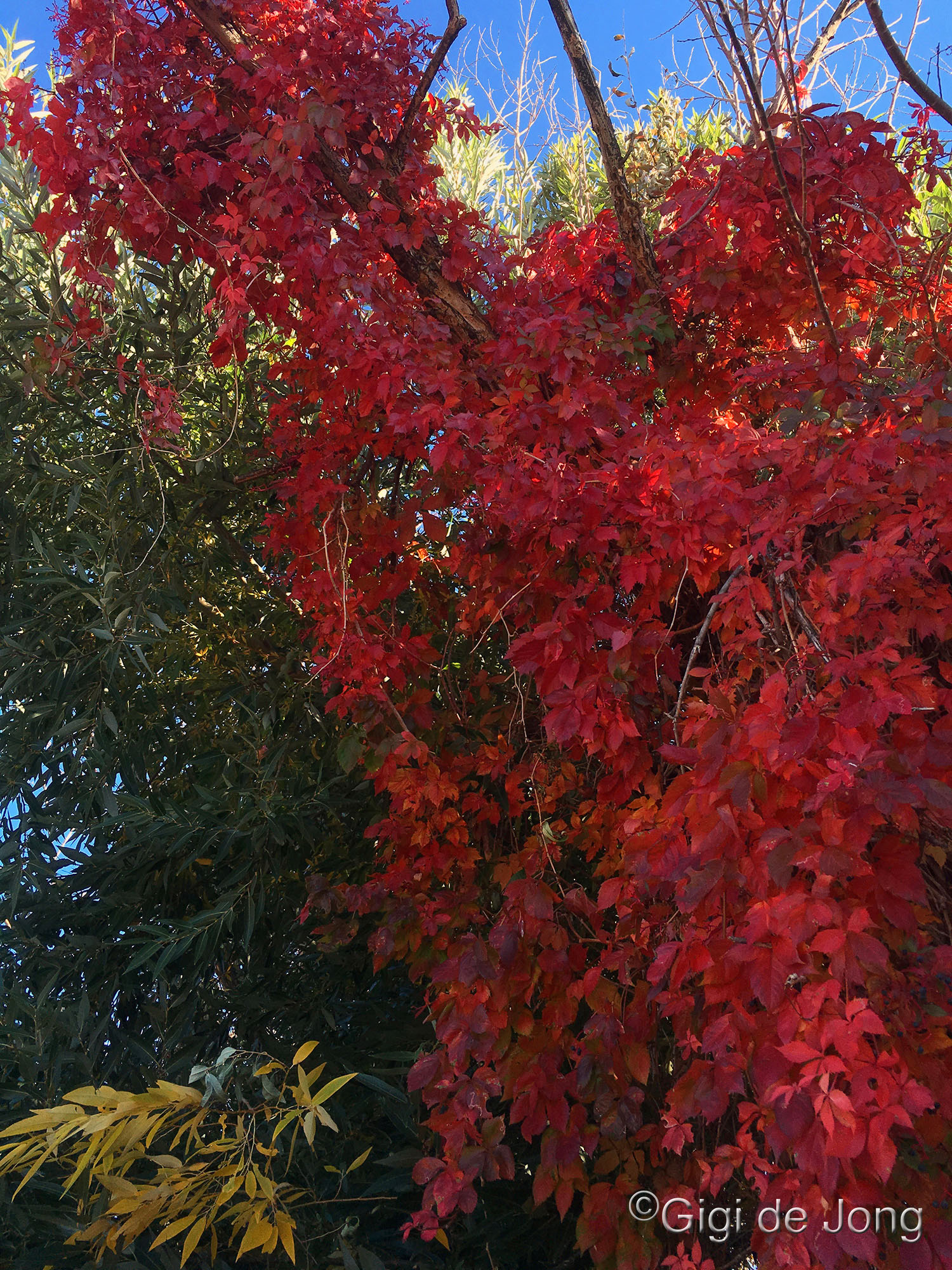
By mid October the color has permeated the town and swept over the plain to the river. There are large and small cottonwood trees dotted all across the northern Owens Valley floor. Some are loners, others in groves. By late October they will show the telltale signs of winter approaching ranging from fully yellow with burnished orange tips to an overall bronzed orange. Thick creeping vines curl around gnarled old wood of fence posts and dead trees turn a deep fiery red.
A high point along Eastside Rd. that runs along the base of the White Mountains provides a panoramic view of the Owens River valley and the Sierra Nevada beyond. Early morning and sunset are magnificent out here. The creek, marshes and ponds along Buckley Ponds Rd. have abundant birdlife and the reeds are a shimmering copper color.
What and Why
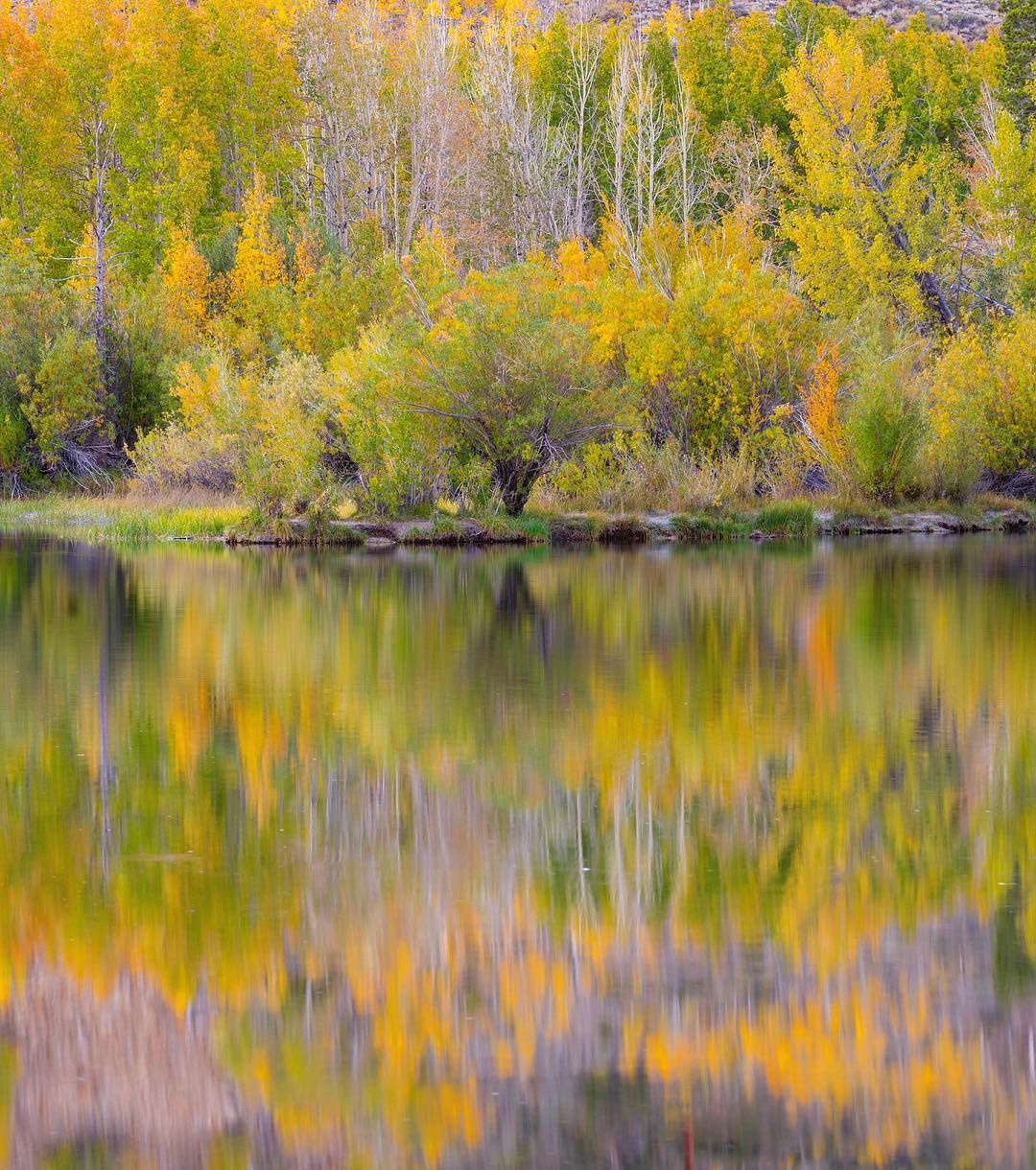
The principal players in this spectacular display of color are aspen, willow, and cottonwood trees. The mountain alder, a shrub belonging to the birch family, participates too and, in a very few stands where it occurs, the California black oak adds a deep, rich color to the palette.
All Thanks to Chlorophyll or Lack of It
The green color of summer comes from chlorophyll, a pigment concentrated in the leaves. During this time, leaves produce food for the plant by making sugars through photosynthesis, thanks to chlorophyll.
In autumn, as daylight hours shorten, chlorophyll levels begin to drop. As it fades, other colors start to appear—beginning with yellow. Once the chlorophyll is completely gone, deeper and richer colors, like red and purple, emerge.
Plants produce more sugars than they need to survive. This excess sugar in the leaves can influence the intensity of color change. A strong growing season in summer, followed by the right balance of light and temperature in fall, leads to more vibrant red tones.
Resources
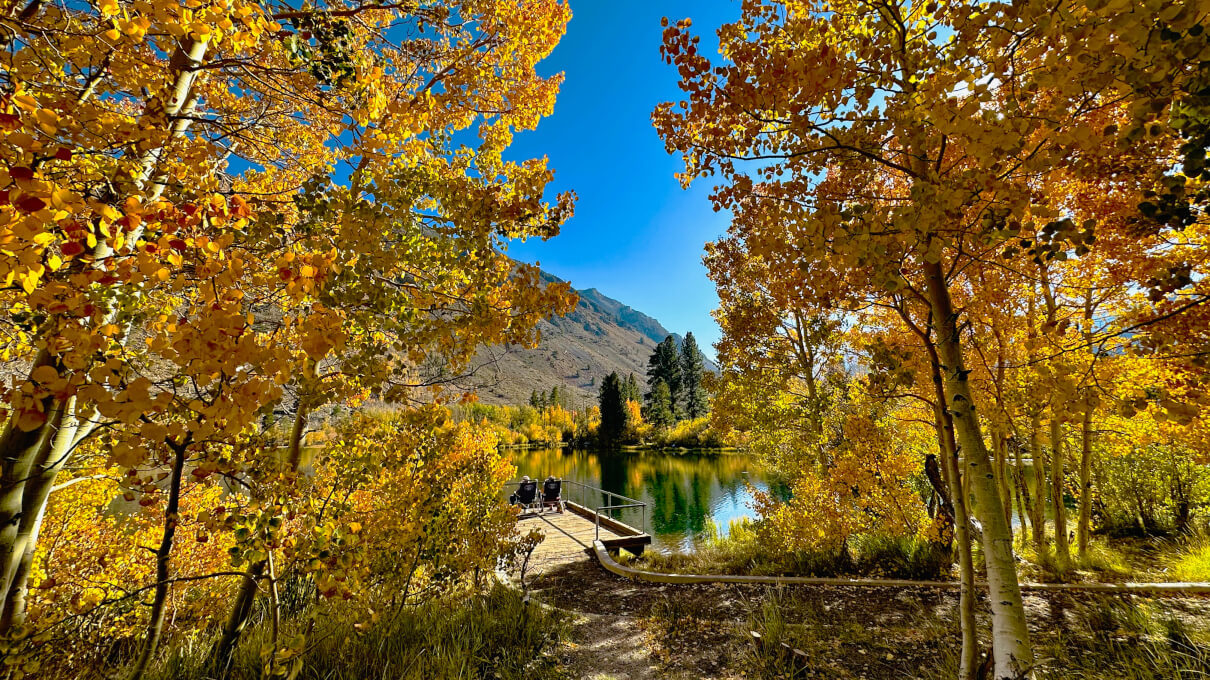
One of the most comprehensive and up to date websites for tracking fall color in California is californiafallcolor.com. It’s a seasonal news site that reports on autumn’s show throughout California.
The Eastern Sierra is one of the most photographed areas in California.
We’re pretty sure, and a great many people would agree with us, that the Eastern Sierra is quite likely the very best location for fall color spotting and photography in California, maybe the whole country.
“Location is everything.”
Take a look at this at this excellent fall color guide and map, download it, print it, take it with you and enjoy the fall colors of the Eastern Sierra.
The best place to start your Eastern Sierra fall color spotting is at the Bishop Visitor Center at 690 N. Main St. in Bishop. We’ll give you just the maps you need! Come in and chat with our friendly, knowledgeable staff. Or call ahead at (760) 873-8405 and let us help you plan your fall fantasy.
Get Outside on the Eastside!

